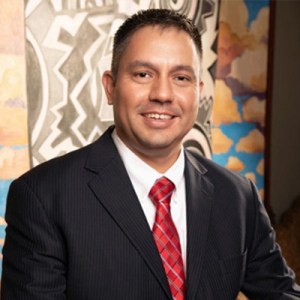One way the SF Fed deepens our understanding of local economic conditions in our District is to engage with and learn from our communities on how they are experiencing the economy. In my role as senior outreach manager focused on Tribal and Indigenous communities, I’ve had the opportunity to meet with leaders from Alaska Native, Native American, Native Hawaiian, and Indigenous communities over the last several months. Here’s what I’ve learned so far—and how we’re planning to strengthen our relationships with communities across the Twelfth District to better understand economic conditions and meet our mission for a sound and stable economy.
Native CDFIs: Enriching economic conditions in local communities
Community development financial institutions (CDFIs) play a key role in economic development efforts and advancing opportunity. Importantly, CDFIs also represent key stakeholders in the advancement of community and economic development efforts in Indian country.
At the Native CDFI Network (NCN) Annual Policy & Capacity Building Summit in December, I joined colleagues from the Federal Reserve Banks of St. Louis, Minneapolis, and Kansas City on a panel to share Reserve Bank information, resources, and opportunities to partner on community-based research. Resources included:
- The Native American Labor Market Dashboard, which provides labor market metrics for the American Indian and Alaska Native population;
- The Native American Financial Institutions Map, which shows locations and asset sizes of banks and credit unions owned by, and CDFIs primarily serving, American Indian, Alaska Native, and Native Hawaiian individuals and communities; and,
- The Native Economic and Financial Education Empowerment program, a Federal Reserve System effort to provide economic and personal finance education for Tribal nations and Native communities and organizations.
Listening sessions with communities in Oregon, Idaho, and Hawai‘i
I also engaged with community leaders at the National Center for American Indian Enterprise Development (NCAIED)’s Reservation Economic Summit (RES). This national summit brings together respected Tribal leaders, members of Congress, federal agency representatives, state and located elected officials, and CEOs to discuss issues important to Tribal and Indigenous communities. The 2023 event represented one of the largest Summits in NCAIED’s 50 years of existence with over 4,000 attendees participating.
I was thrilled to be able to host three listening sessions at RES with Indigenous organizations and tribes from Oregon, Idaho, and Hawai‘i. These sessions are a way to acknowledge and show respect for Tribal sovereignty1 and to enhance trust between the Bank and these communities. This builds a foundation for the Bank to deepen our understanding of the needs and concerns of tribes and Indigenous organizations as it relates to the economy, which ultimately helps us meet our mission.
Two major themes emerged from our talks: the need for multiple sources of revenue, and for additional capital and funding for small business, housing, and infrastructure in Tribal and Indigenous communities. Remarks by one tribe’s community and economic development coordinator emphasized that additional investment into both urban and rural Native American communities will be key as tribes look to diversify their economies beyond the gaming industry.
Supporting Native Hawaiian small businesses
Most recently in April, I met with Native Hawaiian small businesses and contractors at the Native Hawaiian Organizations Association (NHOA) Small Business Summit. I learned about some of the unique challenges that they continue to face in the post-COVID-19 business environment.
Many business owners said access to capital and difficulty in attracting workers continue to be the top economic development issues they face. At the same time, I learned that federal contracting opportunities represent a key pathway for many Indigenous-owned businesses to grow and expand in the future.
The leaders I met with shared that Native Hawaiian contracting can help maintain cultural preservation and increase community engagement. Native Hawaiian businesses often incorporate Hawaiian cultural values and practices into their operations—similar to the benefits Tribal Nations have seen through their experiences with contracting opportunities.2 Additionally, Native Hawaiian businesses are often deeply connected to their communities and have a vested interest in the well-being of the community.
Next steps for engagement
To follow up on the key theme of contracting opportunities that support Tribal and Indigenous communities, the SF Fed is partnering with the Federal Reserve Bank of Minneapolis’s Center for Indian Country Development on a webinar related to federal contracting opportunities for Alaska Native, Native American, Native Hawaiian, and Indigenous communities.
The event will be held on June 21. For more information and to sign up to attend, visit the 2023 Center for Indian Country Development Webinar Series: Opportunities and Barriers in Native Federal Contracting website.
You may also be interested in:
- Our commitment to supporting Alaska Native, Native American, Native Hawaiian, and Indigenous communities
- Community perspectives and conditions from the Fed’s Beige Book, May 2023
- 2024 National Interagency Community Reinvestment Conference
1. “Sovereignty is a legal word for an ordinary concept—the authority to self-govern. Hundreds of treaties, along with the Supreme Court, the President, and Congress, have repeatedly affirmed that Tribal nations retain their inherent powers of self-government. These treaties, executive orders, and laws have created a fundamental contract between tribes and the United States.” From “Tribal Governance.” National Congress of American Indians. Accessed on June 12, 2023.
2. Chavis, Larry, Matthew Greg, and Elijah Moreno. 2022. “Federal contracting’s expanding revenue role in Indian Country: Analysis of a new Center for Indian Country Development dataset shows Native entities’ increasing participation in the federal contracting industry.” Federal Reserve Bank of Minneapolis. Accessed on June 13, 2023.
The views expressed here do not necessarily reflect the views of the management of the Federal Reserve Bank of San Francisco or of the Board of Governors of the Federal Reserve System.

